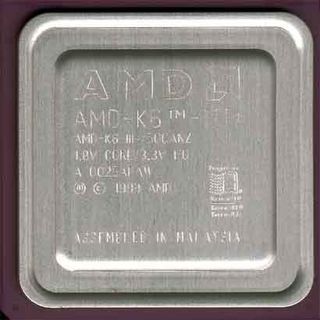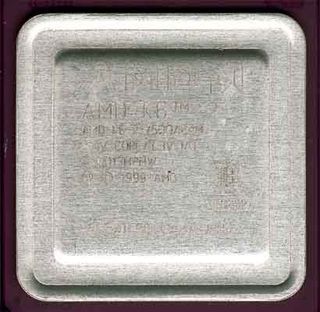Socket 7: Fit For Years To Come!
Socket7 Triangle: AMD K6-2, AMD K6-2+ And AMD K6-III+, Continued
In contrast to the K6-2/500, the AMD K6-2+/500 as well as AMD K6-III+/500 have full-speed on-die L2 cache under the hood. The only difference is the size. The K6-2+ uses 128 kB while the K6-III+ has 256 kB. Integrated L2 cache became possible because these two CPUs are manufactured in 0.18 micron process. The old K6-2 is still made using 0.25µ-process. By the way, you don't have to disable the cache modules on your socket7 motherboard. When a K6 processor has on-die L2 cache those external modules function as 'L3 cache', which improve performance a little bit further. We want to emphasize one point right away: AMD has not aimed the abovementioned 'Plus' processors at the end user market. While some retailers offer the AMD K6-2+/500 in small numbers, the AMD K6-III+/500 is exclusively sold to OEMs. Compaq, for example, uses this processor with their cheaper Notebooks. Unlike traditional K6-2 CPUs, the K6-2+/K6-III+ processors are equipped with the power saving technology 'PowerNow', AMD's copy of Intel's SpeedStep technology. This technology enables users to drastically reduce power consumption. Especially in battery mode the CPU clock rate can be slowed down thereby increasing battery running time.

The new AMD K6-III+/500 is shown here, which is the fastest CPU for Socket7! Equipped with an 256 kB on-Die L2 cache it reaches impressive benchmark results.

With the exception of a smaller L2 cache (128 kB), AMD K6-2+/500 is absolutely identical to K6-III+/500. Both CPUs come with the new PowerNow technology.

AMD K6-2/500 is a very good and cheap upgrade solution for older systems based on socket7.
Stay on the Cutting Edge
Join the experts who read Tom's Hardware for the inside track on enthusiast PC tech news — and have for over 25 years. We'll send breaking news and in-depth reviews of CPUs, GPUs, AI, maker hardware and more straight to your inbox.
Current page: Socket7 Triangle: AMD K6-2, AMD K6-2+ And AMD K6-III+, Continued
Prev Page Socket7 Triangle: AMD K6-2, AMD K6-2+ And AMD K6-III+, Continued Next Page CPU Upgrade - Which Boards Support It?Most Popular

